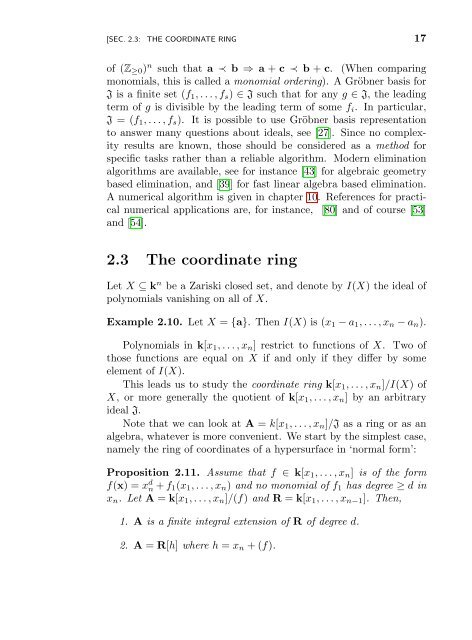Nonlinear Equations - UFRJ
Nonlinear Equations - UFRJ
Nonlinear Equations - UFRJ
You also want an ePaper? Increase the reach of your titles
YUMPU automatically turns print PDFs into web optimized ePapers that Google loves.
[SEC. 2.3: THE COORDINATE RING 17<br />
of (Z ≥0 ) n such that a ≺ b ⇒ a + c ≺ b + c. (When comparing<br />
monomials, this is called a monomial ordering). A Gröbner basis for<br />
J is a finite set (f 1 , . . . , f s ) ∈ J such that for any g ∈ J, the leading<br />
term of g is divisible by the leading term of some f i . In particular,<br />
J = (f 1 , . . . , f s ). It is possible to use Gröbner basis representation<br />
to answer many questions about ideals, see [27]. Since no complexity<br />
results are known, those should be considered as a method for<br />
specific tasks rather than a reliable algorithm. Modern elimination<br />
algorithms are available, see for instance [43] for algebraic geometry<br />
based elimination, and [39] for fast linear algebra based elimination.<br />
A numerical algorithm is given in chapter 10. References for practical<br />
numerical applications are, for instance, [80] and of course [53]<br />
and [54].<br />
2.3 The coordinate ring<br />
Let X ⊆ k n be a Zariski closed set, and denote by I(X) the ideal of<br />
polynomials vanishing on all of X.<br />
Example 2.10. Let X = {a}. Then I(X) is (x 1 − a 1 , . . . , x n − a n ).<br />
Polynomials in k[x 1 , . . . , x n ] restrict to functions of X. Two of<br />
those functions are equal on X if and only if they differ by some<br />
element of I(X).<br />
This leads us to study the coordinate ring k[x 1 , . . . , x n ]/I(X) of<br />
X, or more generally the quotient of k[x 1 , . . . , x n ] by an arbitrary<br />
ideal J.<br />
Note that we can look at A = k[x 1 , . . . , x n ]/J as a ring or as an<br />
algebra, whatever is more convenient. We start by the simplest case,<br />
namely the ring of coordinates of a hypersurface in ‘normal form’:<br />
Proposition 2.11. Assume that f ∈ k[x 1 , . . . , x n ] is of the form<br />
f(x) = x d n + f 1 (x 1 , . . . , x n ) and no monomial of f 1 has degree ≥ d in<br />
x n . Let A = k[x 1 , . . . , x n ]/(f) and R = k[x 1 , . . . , x n−1 ]. Then,<br />
1. A is a finite integral extension of R of degree d.<br />
2. A = R[h] where h = x n + (f).

















